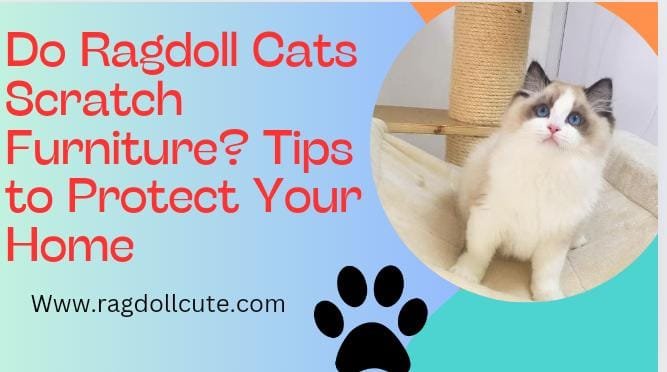If you’re a cat lover considering adopting a Ragdoll cat, you may have questions about their behavior, especially regarding scratching. One question that often arises is, “Do Ragdoll cats scratch furniture?” Scratching can lead to damaged furniture, frustration, and even tension between you and your furry friend.
In this article, we will explore whether Ragdoll cats are prone to scratching furniture, why they scratch in the first place, and—most importantly—how you can protect your home while keeping your Ragdoll happy and content. We’ll dive into practical advice, actionable strategies, and useful tips to help you effectively manage this natural feline behavior.
Do Ragdoll Cats Typically Scratch Furniture?
The simple answer is yes, Ragdoll cats do scratch. However, they typically do so less aggressively than other breeds. Their calm demeanor and low energy levels make them less likely to scratch destructively. This makes Ragdolls ideal for families looking for a cat breed that is more likely to fit well with a home environment where scratching is a concern.
However, every cat is unique, and a Ragdoll may develop a scratching habit if they are not provided with the appropriate outlets. It’s important to remember that scratching is instinctual for cats. It is not done to be malicious but serves several important functions for their well-being. Ragdolls need a place to scratch, and giving them the right tools and training can help redirect their scratching away from your sofa or other valuable items.
Reasons Why Ragdoll Cats Scratch
Scratching is an inherent part of feline behavior, and understanding why cats scratch can help you manage it effectively. Here are some reasons why Ragdolls, and cats in general, scratch:
Claw Maintenance: Scratching helps cats shed the outer layer of their claws, which keeps them sharp and healthy. This natural grooming behavior is essential for their overall health.
Territorial Marking: Cats have scent glands in their paws. When they scratch, they leave both visual and scent markers, which communicate to other animals that a territory has been claimed. Although Ragdolls are less territorial, the instinct is still present.
Stretching and Exercise: Scratching allows cats to stretch their muscles and flex their joints, particularly after periods of rest. It’s similar to when humans stretch after sitting for a long time, and it helps keep cats agile.
Stress Relief and Emotional Outlet: Scratching can also serve as a way for cats to relieve stress or pent-up energy. If a Ragdoll is feeling anxious, bored, or frustrated, scratching may provide an outlet for those emotions.
How to Prevent Ragdoll Cats from Scratching Furniture
Preventing your Ragdoll from scratching your furniture is all about being proactive and creating an environment that meets their needs. Here are some effective methods:
1. Provide Scratching Posts
Scratching posts are a vital tool for preventing unwanted scratching. Place them in areas where your Ragdoll likes to spend time. Make sure these posts are tall and sturdy, as Ragdolls are large cats and enjoy stretching. Sisal-wrapped posts are ideal because cats find the texture very appealing.
2. Use Deterrent Sprays
Cat-safe deterrent sprays can make your furniture less appealing to your Ragdoll. Sprays often contain scents that cats dislike, such as citrus or lavender, which can help to deter scratching behavior. It’s important to pair deterrents with positive reinforcement for using the correct scratching areas.
3. Positive Reinforcement Training
When you see your Ragdoll using their scratching post instead of your furniture, reward them with a treat, verbal praise, or affection. This helps build a positive association with the scratching post and encourages them to use it again in the future.
4. Redirection
If you catch your Ragdoll scratching furniture, gently redirect them to an appropriate scratching post. Use toys or treats to guide them and ensure that the post is always easily accessible. Consistency is key to breaking habits.
5. Trimming Claws
Regularly trimming your cat’s claws can reduce the damage they might cause if they scratch your furniture. Use a pair of dedicated cat nail clippers and trim only the sharp tips of the claws. If you’re uncomfortable doing this yourself, consult a veterinarian or groomer.
6. Cat Furniture and Multiple Options
Providing multiple scratching options—like scratching posts, pads, and cat furniture—gives your Ragdoll a variety of places to scratch. This encourages them to use acceptable items instead of furniture.

Choosing the Right Scratching Post
Not all scratching posts are the same, and selecting the right one can make a big difference in how willing your Ragdoll is to use it. Consider the following factors:
Material: Sisal rope is one of the most preferred materials for scratching posts. However, some Ragdolls may prefer carpet or cardboard. Providing different textures helps identify what your cat enjoys most, and using a combination can keep them interested.
Height: Ragdolls are larger than average cats, so a tall scratching post that allows for a full-body stretch is ideal. Cats love being able to stretch upwards and use their full length when scratching.
Stability: A wobbly scratching post is unlikely to be used by any cat, including Ragdolls. Cats need a sturdy post that remains still when they lean into it.
Alternatives to Furniture Scratching
Providing alternatives to furniture is the key to preventing unwanted scratching. Here are some excellent options:
Cat Furniture
There are specially designed pieces of cat furniture that serve as both a bed and a scratching surface. These multi-functional pieces can be particularly appealing to Ragdolls, who love to lounge and scratch. Investing in such items keeps your Ragdoll entertained and ensures they have a suitable place to scratch.
Scratching Pads
Cardboard scratching pads are an affordable and effective solution. Cats love the texture of cardboard, and these pads can be placed in multiple locations throughout the home.
Cat Trees
Cat trees serve a dual purpose—they provide scratching surfaces, and they also give your Ragdoll a place to climb, perch, and relax. Since Ragdolls enjoy lounging and spending time near their humans, a strategically placed cat tree can be an excellent way to redirect scratching behavior.
Interactive Toys
Engaging your Ragdoll with interactive toys helps reduce boredom. Laser pointers, wand toys, and balls can keep them entertained and provide a mental and physical outlet, reducing the likelihood of scratching due to pent-up energy.
FAQs
Do Ragdoll Cats Need Scratching Posts?
Absolutely. Even though they may not scratch as much as other breeds, Ragdolls still need an outlet for scratching to maintain healthy claws, stretch their muscles, and relieve stress.
Are There Specific Materials Ragdolls Prefer for Scratching?
Many Ragdolls prefer sisal rope or carpet-covered posts, but it’s important to experiment to find what your cat likes best. Cardboard is another popular material—try providing multiple textures to see which one your Ragdoll favors.
Can Declawing Stop Scratching?
Declawing is not a humane solution. It is a painful and often harmful procedure that involves amputating part of the cat’s toes. Declawing can lead to physical and behavioral issues, including chronic pain, arthritis, and increased aggression. There are many better, kinder ways to manage scratching behavior, such as providing suitable scratching posts, using deterrents, and reinforcing positive behaviors.
Conclusion
In conclusion, Ragdoll cats do have natural scratching behaviors, but their calm nature often makes them less destructive than some other breeds. By providing the right tools—scratching posts, deterrents, positive reinforcement, and cat-specific furniture—you can help protect your furniture while keeping your Ragdoll happy and healthy. Scratching is a natural and necessary activity for all cats, and giving them appropriate outlets ensures that you can maintain a harmonious home without sacrificing your favorite couch.
If you’ve found these tips helpful or have personal experiences with Ragdoll cats, we’d love to hear from you! Please leave a comment below to share your story, ask questions, or let us know what has worked best for you. We’re all in this together, and your experiences can help others, too.

Hey guys, My name is Simon Smith. I’m from Canada and live near Victoria
I live with my sweet family and have 20+ Ragdolls of different types. I love them as my children. My profession is as a hotel manager.
I love to keep Ragdolls and grow their breeder case. I have 7 years of experience.
I’m an expert in cat care. So, I’m here to provide you with new information about my cats daily. This is my blog website, so I request that you kindly visit our site daily.
If you’re a Ragdolls lover and you have any questions or confusion about cats, text me on the Contact Us page or Gmail.
Thank u
